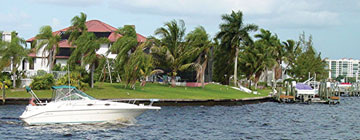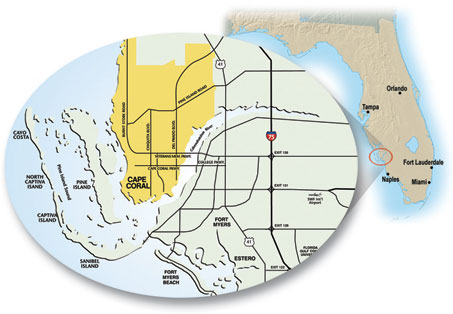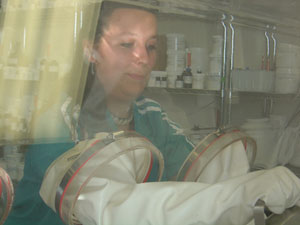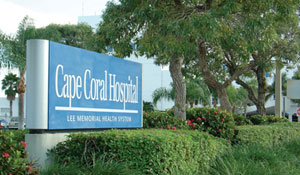An Editorial Profile: Cape Coral, Florida
Booming in a Boomtown State

|
| Cape Coral is a boater's paradise with 222 miles (355 km.) of saltwater access canals, 31 miles (50 km.) of shoreline and 156 miles (250 km.) of fresh-water canals. The city maintains the canals as a navigible waterway system. Boaters travel typically less than an hour to reach the Gulf of Mexico. |
While many corporate real estate executives and site selection consultants still can't place Cape Coral on the map, the city has forever changed the map of Lee County and quietly become Florida's most populous city between Tampa and Miami. Not even Bradenton, Sarasota, Fort Myers or Naples can claim that distinction.
Property values, too, are escalating at an unprecedented rate. Over the last four years, real estate values have increased by rates, respectively, of 17 percent, 28 percent, 30 percent and 49 percent. During that time, an average single-family home on the Cape increased in value from around US$80,000 to $200,483.
And the growth isn't stopping. The Cape is the third largest city in land mass in Florida — covering 115 square miles (298 sq. km.) — meaning that the city has plenty of room to accommodate more residents and the businesses that will employ and serve them.
 |
Mike Jackson, director of economic development for Cape Coral, says that the city will not reach buildout until 2080, when it will have 413,000 residents.
While numbers alone don't tell the whole story, they are important:
• In the past year, the city has announced or completed more than 50 new commercial and/or industrial construction projects of $1 million or greater.
• The city's industrial market and office market both have vacancy rates of 0 percent. "When new space is built here, it is filled immediately," says Jackson.
• The city is growing so fast that it now must export 60 percent of its work force of 69,251 every day to places like Fort Myers and Naples because the companies cannot come to Cape Coral fast enough to employ all the people who want to work on the Cape.
• New ventures are growing at the rate of 12 percent annually on the Cape, which already is home to more than 7,500 different businesses.
• About 75 percent of Florida's 17.51 million people live within 150 miles (240 kilometers) of Cape Coral, which is easily accessed via Interstate 75, U.S. Highway 41 and the rapidly expanding Southwest Florida International Airport in nearby Fort Myers.
• The tri-county (Charlotte, Lee and Collier) work force of 383,000 provides skilled labor in marine fabrication, information technology, marine sciences, life sciences, telecommunications, financial services, health care, back-office and customer contact fields.
• The Milken Institute last year named Cape Coral-Fort Myers as the No. 1 Best Performing City in the nation for job growth, climbing two spots from third place the year before. From 1999 through 2003, the metro area's job growth rate was an astounding 20.2 percent.
• Nova Southeastern University, International College and Florida Gulf Coast University have established classes at an interim campus in Cape Coral. The Cape is creating a 180-acre (73-hectare) Academic Village, where students will be able to attend classes offered by a consortium of colleges and universities.
• Through September 2005, the city had issued 7,694 new home permits for the year. The city is growing at a rate of 1,200 new residents every month.

|
| Acology is a prescription compounding company that relocated from Idaho to Cape Coral in 2003. The company works directly with physicians to formulate pharmaceuticals that are customized for a patient's unique needs. |
Joel Kronfeld, managing partner of Lion Paw LLC and developer of the Central Cape Business Park along the city's largest business and industrial corridor — Pine Island Road — characterizes the growth of Cape Coral this way: "I am watching a city being born."
Like Ezerins, Kronfeld said goodbye to the snowstorms of the Northeast and moved himself and his business to Cape Coral, where there's sunshine 335 days a year and the average annual temperature is 74.4 degrees.
Kronfeld is part of a building boom

|
| Cape Coral Hospital is a 281-bed acute care facility that is part of the Lee Memorial Health System. The hospital is listed as one of the nation's 100 Top Hospitals®. In addition to this award-winning facility, the health system's data and medical coding functions are also located in Cape Coral. |
"This is like Queens, New York, before it was built up," says the New York native turned Florida developer. "They are totally building a city here. This is literally the land of golden opportunity."
It didn't take long for Kronfeld to discover his own gold. He built 94,000 sq. ft. (8,733 sq. m.) of new flex/industrial space on Pine Island Road, the city's dividing line between North Cape and South Cape, and completely filled every bay before the complex officially opened in November 2005.
"All the realities of growth are here, and yet until recently there was virtually no commercial or industrial space to be found anywhere in the city," says Kronfeld. "As soon as the front of my new buildings went up, we leased the space. It is the basic law of supply and demand."
The supply is an affluent generation of aging Boomers who find the mild climate and almost 400 miles (640 kilometers) of inland waterways (more canals than any other city in America) too inviting to pass up. These waterfront-living, boat-loving entrepreneurs are attracted by one other thing: a cost of living that, by South Florida's standards, is downright affordable.
The cost of a new house in Cape Coral still averages $100,000 less than a comparable home in Fort Lauderdale on Florida's other coast. Every home in Cape Coral comes with waterfront access or is only minutes away.

